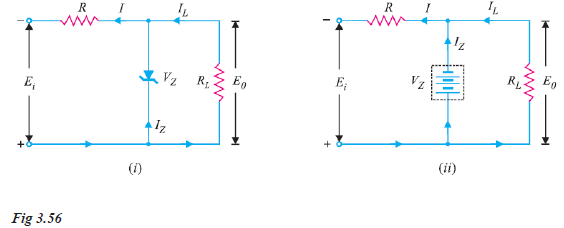- A Zener diode can be used as a voltage regulator to provide a constant voltage from a source whose voltage may vary over sufficient range. The circuit arrangement is shown in Fig. 3.56 (i). The Zener diode of Zener voltage V
Z is reverse connected across the load R
L across which constant output is desired. The series resistance R absorbs the output voltage fluctuations so as to maintain constant voltage across the load. It may be noted that the Zener will maintain a constant voltage V
Z (= E
0) across the load as long as the input voltage does not fall below V
Z.

- When the circuit is properly designed, the load voltage E
0 remains essentially constant (equal to V
Z) even though the input voltage E
i and load resistance R
L may vary over a wide range.
(i) Suppose the input voltage increases. Since the Zener is in the breakdown region, the Zener diode is equivalent to a battery V
Z as shown in Fig. 3.56 (ii). It is clear that output voltage remains constant at V
Z (= E
0). The excess voltage is dropped across the series resistance R. This will cause an increase in the value of total current I. The Zener will conduct the increase of current in I while the load current remains constant. Hence, output voltage E
0 remains constant irrespective of the changes in the input voltage E
i.
(ii) Now suppose that input voltage is constant but the load resistance R
L decreases. This will cause an increase in load current. The extra current cannot come from the source because drop in R (and hence source current I) will not change as the Zener is within its regulating range. The additional load current will come from a decrease in Zener current I
Z. Consequently, the output voltage stays at constant value.
Voltage drop across R = E
i - E
0 Current through R, I = I
Z + I
L Applying Ohm‘s law, we have,

Wilfykil answered the question on
August 14, 2019 at 09:35